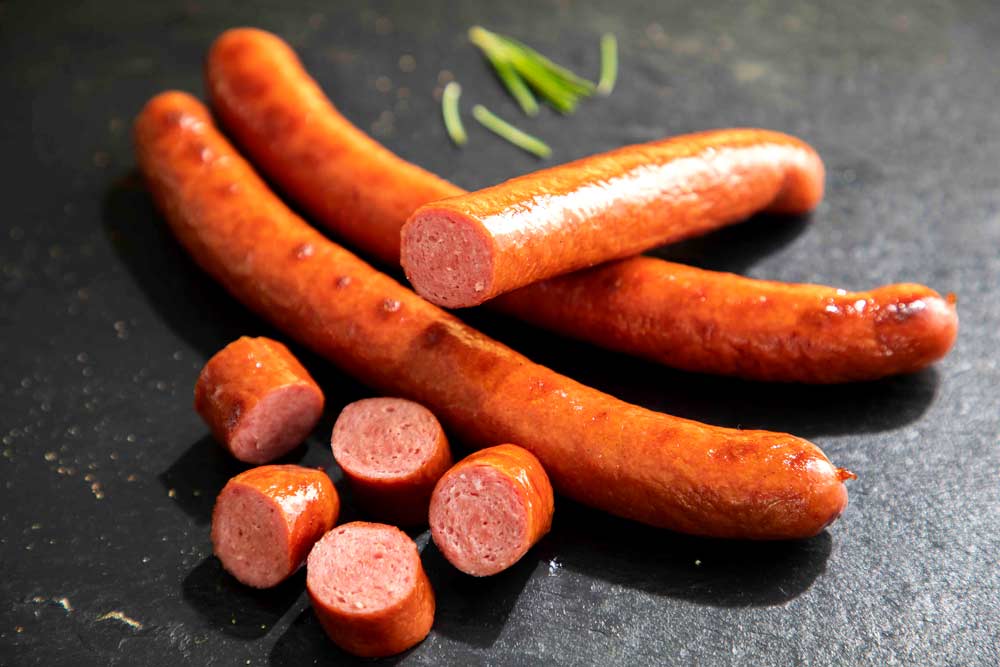What is Sausage Made Of: All You Need to Know
What is Sausage Made Of
Sausage is typically made from ground meat, often pork, beef, or a combination of meats, along with various seasonings, spices, and sometimes other ingredients like herbs, vegetables, or grains. The exact ingredients can vary widely depending on the type of sausage being made and regional preferences. Additionally, sausage casings can be natural (made from the intestines of animals) or synthetic. The mixture is typically stuffed into casings, shaped, and then cooked or cured before consumption.
Introduction to Sausage
Sausage, a staple of many cuisines, is a seasoned ground meat mixture typically encased in a casing. This versatile food item can be made from various types of meat, including pork, beef, chicken, and even game meats like venison or duck. Sausages are celebrated for their rich flavor profile and can be enjoyed in a multitude of dishes, from breakfast scrambles to gourmet entrées. Read about What Is Poutine
Historical Background
The history of sausage making traces back thousands of years, with evidence of its existence found in ancient civilizations such as Mesopotamia and Egypt. Early sausages were simple mixtures of ground meat and seasonings, often stuffed into animal intestines for preservation. Over time, sausage recipes evolved, incorporating regional ingredients and culinary techniques.
Types of Sausage
Sausages can be broadly classified into several categories based on their preparation method and ingredients. Fresh sausages are made with raw meat and must be cooked before consumption. Cooked sausages, on the other hand, are pre-cooked during the manufacturing process and can be eaten cold or reheated. Smoked sausages are infused with smoky flavor through a curing process involving smoke exposure, while dry sausages are air-dried to achieve a firm texture and concentrated flavor. Discover about How to Thicken Mashed Potatoes
Ingredients in Sausage Making
The key to crafting delicious sausages lies in selecting high-quality ingredients and striking the right balance of flavors. While the exact ingredients vary depending on the sausage recipe, common components include:
- Meat Selection: Lean cuts of pork, beef, or poultry are commonly used as the base ingredient for sausages. The type of meat chosen influences the final taste and texture of the sausage.
- Fat Content: A certain amount of fat is essential for creating juicy and flavorful sausages. Pork fat, known as back fat or lard, is often added to the meat mixture to enhance moisture and mouthfeel.
- Seasonings and Spices: From aromatic herbs like sage and thyme to bold spices like paprika and garlic, seasonings play a crucial role in defining the flavor profile of sausages. Salt is a fundamental ingredient that helps to enhance taste and preserve the meat. Learn about What is Oolong Milk Tea
The Process of Making Sausage
Sausage making is a meticulous process that involves several steps, each crucial for achieving the desired texture and flavor. The basic steps include:
- Grinding and Mixing: The meat and fat are ground together to a uniform consistency, ensuring even distribution of flavors and moisture. Seasonings and spices are then added to the meat mixture and thoroughly mixed.
- Stuffing and Casing: The seasoned meat mixture is stuffed into casings, which can be made from natural materials like animal intestines or synthetic alternatives. Casings help to shape the sausage and retain its form during cooking.
- Cooking or Curing: Depending on the type of sausage being made, it may be cooked immediately after stuffing or undergo a curing process to develop flavor and texture. Cooking methods vary and can include grilling, frying, baking, or simmering in liquid.
Common Additives
In addition to meat, fat, and seasonings, sausages may contain various additives aimed at improving texture, shelf life, or flavor. Binders such as breadcrumbs or egg whites help to hold the meat mixture together, while fillers like rice or vegetables can enhance volume and moisture retention. Preservatives such as nitrates and nitrites are often used to prevent bacterial growth and extend the shelf life of cured sausages.
Health Considerations
While sausages are undeniably delicious, they are also high in fat, sodium, and calories, making moderation key to a balanced diet. Processed meats, including sausages, have been linked to an increased risk of certain health conditions, such as heart disease and cancer. Opting for leaner cuts of meat, choosing low-sodium varieties, and enjoying sausages in moderation can help mitigate these risks.
Cultural Significance
Sausage holds a special place in the culinary traditions of many cultures around the world. From the spicy chorizo of Spain to the garlicky kielbasa of Poland, sausages are celebrated for their diverse flavors and cultural significance. In some regions, sausages are an integral part of holiday feasts and celebrations, symbolizing abundance and hospitality.
Environmental Impact
The production of meat, including that used in sausage making, can have significant environmental consequences, including deforestation, greenhouse gas emissions, and water pollution. As consumers become more conscious of the environmental impact of their food choices, there is growing interest in alternative protein sources and sustainable farming practices. Plant-based sausages made from ingredients like tofu, seitan, or mushrooms offer a more environmentally friendly option for those looking to reduce their meat consumption.
Quality Control and Regulations
To ensure the safety and quality of sausage products, strict regulations and standards govern their production and labeling. Food safety agencies conduct inspections of manufacturing facilities, monitor ingredient sourcing, and enforce labeling requirements to protect consumers from foodborne illnesses and misrepresentation. Compliance with these regulations is essential for sausage producers to maintain consumer trust and market integrity.
Myths and Misconceptions
Sausage making has its fair share of myths and misconceptions, often fueled by misinformation or cultural stereotypes. Common misconceptions include the notion that sausages are made from undesirable meat scraps or that all sausages are heavily processed and unhealthy. In reality, quality sausages can be crafted from high-quality ingredients and enjoyed as part of a balanced diet.
Cooking Tips and Recipes
Cooking sausages is a straightforward process that offers endless possibilities for creativity and experimentation. Whether grilling on the barbecue, pan-frying on the stovetop, or baking in the oven, sausages can be prepared in various ways to suit different tastes and occasions. Pairing sausages with complementary ingredients like onions, peppers, and mustard can elevate their flavor profile and create memorable dining experiences.
Sausage in Popular Culture
Sausage has permeated popular culture, appearing in literature, film, television, and even music. References to sausages can be found in classic works of literature, such as Shakespeare’s “The Merry Wives of Windsor,” as well as modern films and TV shows like “Parks and Recreation” and “Game of Thrones.” Sausage festivals and events, where enthusiasts gather to sample different varieties of sausage and celebrate their love for this beloved food item, further highlight its cultural significance.
Sausage as a Business
The sausage industry is a thriving sector of the food economy, with a wide range of producers catering to diverse consumer preferences. From artisanal butcher shops specializing in handmade sausages to large-scale manufacturers supplying supermarkets and restaurants, there is no shortage of options for sausage lovers to explore. Market trends indicate a growing demand for premium, ethically sourced sausages made with natural ingredients, reflecting consumers’ evolving preferences for quality and authenticity.

Conclusion
In conclusion, sausage is a versatile and flavorful food item enjoyed by people around the world. From its humble beginnings as a simple mixture of ground meat and spices to the diverse array of varieties available today, sausage continues to captivate taste buds and inspire culinary creativity. Whether enjoyed as a hearty breakfast staple, a savory snack, or a gourmet entrée, sausages offer something for everyone to savor and enjoy.
FAQs
- . Are all sausages made from pork?
- No, sausages can be made from a variety of meats, including beef, chicken, turkey, and even vegetarian options made from plant-based ingredients.
- . Are sausages unhealthy to eat? While sausages can be high in fat, sodium, and calories, choosing leaner varieties and enjoying them in moderation can be part of a balanced diet.
- . Can I make sausages at home?
- Yes, making sausages at home is possible with the right equipment and ingredients. There are many recipes and tutorials available online to guide you through the process.
- . What is the best way to cook sausages? Sausages can be cooked in various ways, including grilling, pan-frying, baking, or boiling. The best method depends on personal preference and the type of sausage being cooked.
- . Are there any vegetarian alternatives to traditional sausages?
- Yes, there are many plant-based sausages available on the market made from ingredients like tofu, seitan, or mushrooms, offering a cruelty-free option for sausage lovers.
